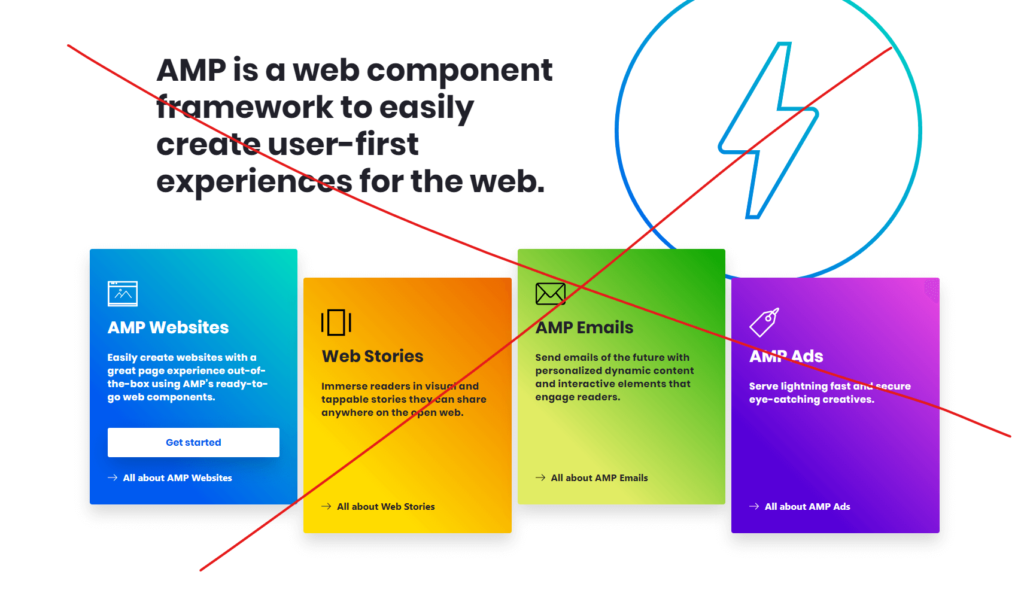
AMP, short for Accelerated Mobile Pages, was announced by Google in 2015 to help publishers swiftly deliver content to readers on their mobile devices. It was a revolutionary idea at its time, but now it’s clear that the program has thankfully failed. This is because other new technologies have been created that are more advanced and produce better search results than AMP ever could.
Core Web Vitals
In July of 2021, Google rolled out the ‘Core Web Vitals” and page experience updates, essentially killing the AMP technology which is widely despised by the web master community.
AMP technology was supposed to help Google keep its users safe from web pages that were slowing their devices down, but Google realized it was time to consolidate all of their efforts into a single platform. Google’s new “Core Web Vitals” framework allows Google to measure the performance and speed of mobile page loading and render times by keeping track of Google Page Speed scores, Google Lighthouse results, user-timing for key page experiences over time (such as visibility of the Google search bar), Google AMP support/availability and more.
Google completed it’s roll out of Core Web Vitals in July of 2021 and gave webmasters a new page experience report – within Search Console – that covers the three main components of Page Experience: LCP, CLS, and FIP.
LCP
LCP is Google’s new way of measuring the load and render times of a webpage. Google uses DataSketch (their version of Chrome ) to gather data on page performance, document complete time, Google AMP support/availability, CDN usage and more.
CLS
CLS stands for “cumulative layout shift” which Google uses as a metric to gauge how many times a website element flashes or jumps on the screen. Jittery sites confuse users and contribute to a loss of trust and perception of low quality to a web site visitor. CLS is a difficult issue to fix and usually requires a developer that understands your website theme and architecture.
FIP
FIP stands for first input delay and Google is using this metric to measure how long it takes for Google to recognize the first input on a webpage. Google’s research has shown that the average mobile user will wait 10 seconds before even considering leaving a page, so Google wants to make sure users are comfortable interacting with your site right from the start.
What to do now that AMP is gone
Google recommends webmasters begin updating their mobile websites to reflect Google’s new Core Web Vitals standards. The search engine is encouraging everyone with an AMP website to remove any Google-owned JavaScript and image assets from their websites so Google doesn’t count the pageviews as AMP views (which can lower your PageSpeed scores). Google has informed webmasters to move AMP code out of the <head> and into the top of Chrome’s DOM tree, but even this is not guaranteed to fix your Google Page Speed score.
Google recommends that you focus on updating your website using cached assets (like CDN, or Cloudflare which we highly recommend), Lighthouse, Search Console, PageSpeed Insights, and Google Analytics to measure how you’re performing as a website.
Google’s new page experience report – located in your Google Search Console account – will show you exactly where your mobile site has problems when users interact with your pages. It also provides a report pointing to problematic URLS that require updates to ensure pages pass Core Web Vital standards
The search engine has suggested that you begin using the AMP framework’s pre-made templates to ensure your mobile websites are Google friendly.
Summary
AMP’s death has changed the way webmasters deal with Google’s onerous requirements for mobile pages, and returned control to the web developers. The SEO community is breathing a huge sigh of relief and has regained control of their mobile user experience. So grab a cool drink, and go make your website better for users now that AMP has drawn it’s last breath.
